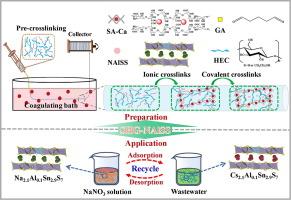Selective removal of cesium from wastewater by salt-resistant hydrogel fiber-supported Al-doped tin sulfide
IF 8.1
1区 工程技术
Q1 ENGINEERING, CHEMICAL
引用次数: 0
Abstract
The extreme pH and complex composition of radioactive wastewater pose great challenges to the chemical stability and properties of adsorbents. Herein, three kinds of metal-doped tin sulfides were developed by a simple one-pot method for cesium removal. DFT calculations combined with experiments were conducted to reveal their structures, stability, and adsorption properties. It was found that the crystal structures of tin sulfide became more stable after doping by Ni and Al. Particularly, the Al-doped material (NAlSS) exhibited the highest stability and adsorption performance because of the highest −COHP value of the Sn-S bond in NAlSS and the low binding energy between NAlSS and Cs+. The industrial application of the powdery NAlSS was further solved by wet spinning using glutaraldehyde cross-linked sodium alginate and hydroxyethyl cellulose (SHG) as the supporters. The obtained salt-resistant hydrogel fibers (SHG-NAlSS) exhibited excellent adsorption performance and stability in wide pH (2 ∼ 12) and temperature (298.15 ∼ 328.15 K) ranges. The maximum adsorption capacity reached 401.34 mg·g−1 within 10 min. The material was successfully applied for Cs+ removal from wastewater, and the distribution coefficient of Cs+ reached 255020.33 mL·g−1. After 10 adsorption–desorption cycles, the adsorbent maintained good stability. These results, along with the fixed-bed adsorption, demonstrate that the developed material can be used as a candidate for Cs+ removal from radioactive wastewater.

求助全文
约1分钟内获得全文
求助全文
来源期刊

Separation and Purification Technology
工程技术-工程:化工
CiteScore
14.00
自引率
12.80%
发文量
2347
审稿时长
43 days
期刊介绍:
Separation and Purification Technology is a premier journal committed to sharing innovative methods for separation and purification in chemical and environmental engineering, encompassing both homogeneous solutions and heterogeneous mixtures. Our scope includes the separation and/or purification of liquids, vapors, and gases, as well as carbon capture and separation techniques. However, it's important to note that methods solely intended for analytical purposes are not within the scope of the journal. Additionally, disciplines such as soil science, polymer science, and metallurgy fall outside the purview of Separation and Purification Technology. Join us in advancing the field of separation and purification methods for sustainable solutions in chemical and environmental engineering.
 求助内容:
求助内容: 应助结果提醒方式:
应助结果提醒方式:


